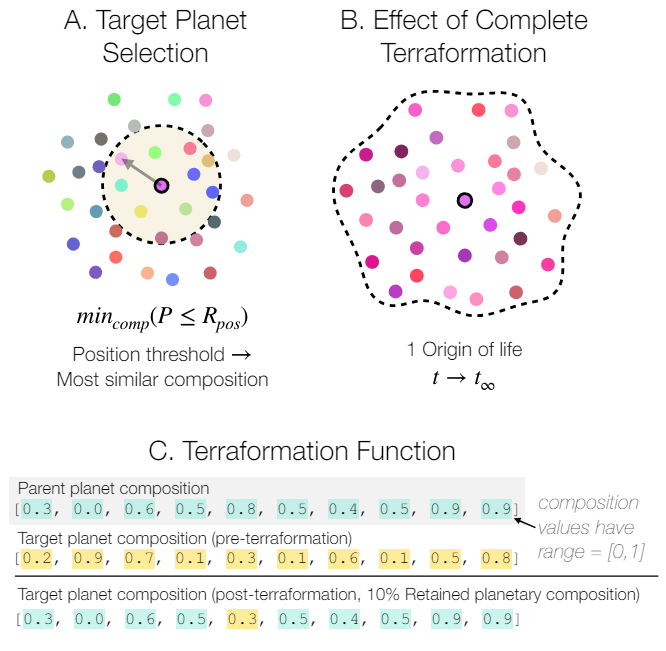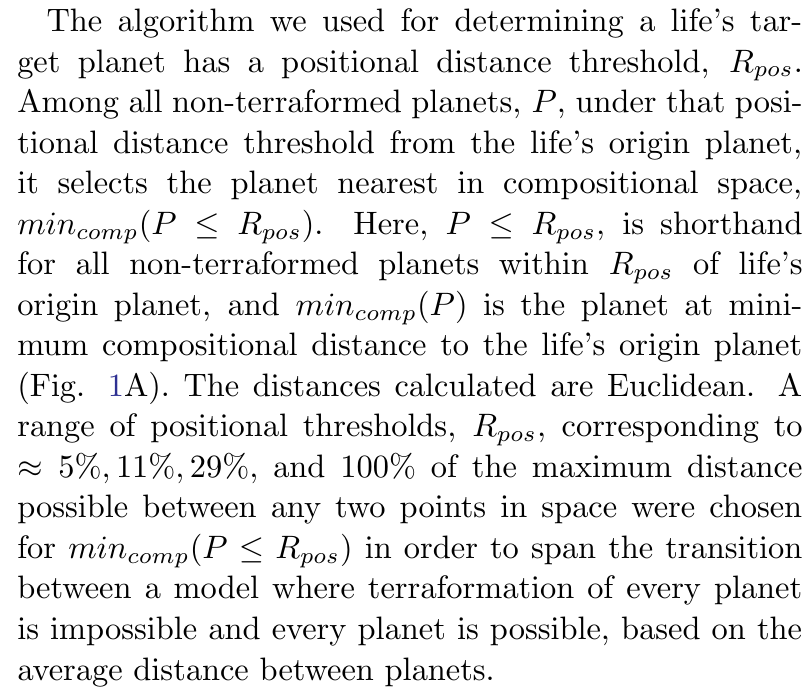Table of Links
2. Methods
2.1. Modeling Panspermia and Terraformation
2.2. Identifying the Presence of Terraformed Planets and 2.3. Software and Availability
3. Results
3.1. Panspermia can increase the correlation between planets’ compositions and positions
3.2. Likely terraformed planets can be identified from clustering
5. Acknowledgements and References
APPENDIX
2.1. Modeling Panspermia and Terraformation
We created an agent-based model to simulate life[2] spreading between planets orbiting different host stars. The model is initialized with 1000 planets (1 of which is terraformed/panspermia-capable), fixed in a frame of reference, and uniformly randomly distributed in a continuous 3D volume. All planets are assumed to be in different star systems (i.e., we assume one planet per star). “Planets” have compositions representing the observable characteristics of the planet, and “life” agents have compositions representing the observable characteristics of the planet which the life originates from. During simulation, terraformed planets [3] emit life towards a target non-terraformed planet at a constant velocity [4]. The target planets are selected based on proximity in position and in composition (see Sec. 2.1.4). When life arrives at a planet, the planet’s composition is modified (terraformed) based on both the initial composition of the planet and the composition of the incoming life. Life originating from that terraformed planet will then reflect its new composition. We assume that the time required for terraformation is negligible compared to the time required to travel between planets. Terraformed planets emit life at a fixed rate, provided suitable target planets exist (see Sec. 2.1.4). The simulation ends when all planets are terraformed, or no suitable target planets remain (Fig. 1B).
2.1.2. Compositions and Terraformation
Both “life” and “planets” have compositions represented by vectors of 10 real numbers (each element ∈ [0, 1]). In our model, these compositions are abstractions, used as a means to compare the compatibility of any given life and planet. While we might in the abstract think of one vector representing the observable characteristics of a planet, this same vector would not represent the same observable characteristics of life compatible with that planet. For life, it instead represents the kind of planetary observable characteristics which are compatible with that life. For example, perhaps a planet’s composition vector V corresponds to an atmosphere composed of 95% CO2 and 5% N2. The same composition vector V in the context of life is used to refer to a kind of life which could be compatible with a planet with an atmospheric composition of 95% CO2 and 5% N2. This does not mean that life on such a planet is literally composed of 95% CO2 and 5% N2. This captures the idea that if a life and a planet have identical composition vectors, then that life will surely be able to terraform the planet[5]. Correspondingly, a life’s composition is identical to the planet from which it emits. Depending on the simulation parameters, initial compositions of each planet are randomly drawn from a uniform distribution. This is a loose approximation of the unknowns surrounding the distribution of diversity of planets between planetary systems (Tasker et al. 2020; Pacetti et al. 2022).
Planet compositions are modified by the process of terraformation, where a mixing function determines how

to generate the terraformed composition based on the non-terraformed planet composition and the incoming life’s composition. We apply a mixing function inspired by horizontal gene transfer, but other mixing functions could also be used. The most important feature we aim to capture is the bi-directional feedback between the terraforming life, and the terraformed planet—such that future life emitted from the terraformed planet will inherit the post-terraformation characteristics of that planet. We keep n = 1 randomly chosen element from the planet’s pre-terraformed composition, and the rest of the terraformed composition is inherited from the terraforming life (Fig. 1C).
2.1.3. Model Stepping

2.1.4. Target Planet Selection
The destination selection aims to balance the need of identifying a target planet that is both compositionally similar, and physically near, the parent planet. This is based on the assumption that life directing panspermia would want to minimize travel time and terraformation energy costs. In the context of lithopanspermia, this could be interpreted as an assumption that beyond a certain positional distance capture becomes vanishingly unlikely, and beyond a certain compositional distance compatibility becomes vanishingly unlikely.

Authors:
(1) Harrison B. Smith, Earth-Life Science Institute, Tokyo Institute of Technology, Ookayama, Meguro-ku, Tokyo, Japan, and Blue Marble Space Institute of Science, Seattle, Washington, USA ([email protected]);
(2) Lana Sinapayen, Sony Computer Science Laboratories, Kyoto, Japan and National Institute for Basic Biology, Okazaki, Japan ([email protected]).
This paper is
[2] In this work, we use life specifically to refer to an agent (used strictly in the “entity” sense of the word agent) traveling from a parent terraformed planet to a target non-terraformed planet, and whose arrival at the target planet triggers terraformation.
[3] We specifically avoid saying living planets, because our methodology cannot distinguish between living planets incapable of panspermia and non-living planets.
[4] This approach is most similar to directed panspermia by intelligent life, but could also be envisioned as undirected lithopanspermia, where we refrain from burdening the simulations with agents that won’t ever be able to interact with planets under the rules of our model.
[5] This is an extreme example where technically life wouldn’t even need to terraform the planet, because it implies that the planet’s observable characteristics already perfectly match the planet from where the life originated.
